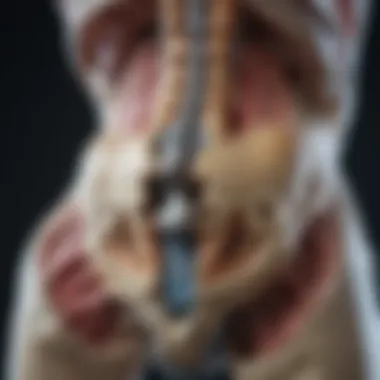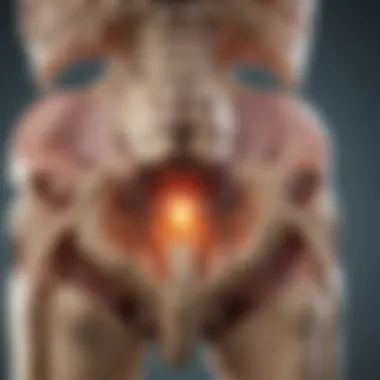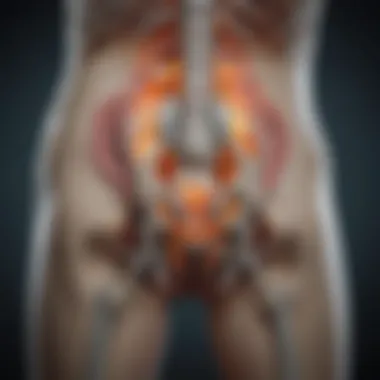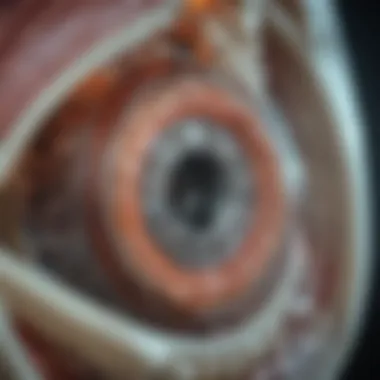MRI of the Sacroiliac Joint: Comprehensive Analysis


Intro
The sacroiliac joint is a critical structure in the human body, connecting the spine to the pelvis. Issues in this area can lead to pain and discomfort, often impacting mobility and quality of life. In recent years, MRI technology has emerged as a vital tool for diagnosing sacroiliac joint disorders. This article offers a comprehensive look into the role of MRI in evaluating this joint, discussing its significance, methodology, and the pathologies it helps reveal.
Overview of Research Topic
Brief Background and Context
The sacroiliac joint serves an important function in load-bearing and weight distribution. Pathologies affecting this joint can result from various factors such as injury, arthritis, or inflammatory conditions. Accurate diagnosis is paramount for effective treatment, and MRI provides a non-invasive, detailed view of the joint structure and surrounding tissues.
Importance in Current Scientific Landscape
With a growing understanding of conditions affecting the sacroiliac joint, research continues to evolve. MRI not only aids in identification but also enhances the precision of treatment strategies. As healthcare professionals seek to improve patient outcomes, the significance of MRI in this context cannot be overstated.
Methodology
Research Design and Approach
The approach taken in assessing MRI's role involves a combination of literature review and analysis of clinical case studies. By collecting and evaluating data on MRI findings related to sacroiliac joint conditions, a rigorous assessment can be made regarding its efficacy.
Data Collection Techniques
Various data sources have been utilized, including peer-reviewed journals, clinical guidelines, and expert opinions. Structured interviews with radiologists familiar with sacroiliac assessments provide further insight, ensuring a comprehensive understanding of the imaging techniques and their applications.
"MRI offers unparalleled precision in visualizing the sacroiliac joint and surrounding structures, making it indispensable in diagnosis and treatment planning."
In this article, we will delve deeper into specific MRI techniques, identify common pathologies, and examine the implications of MRI findings for treatment protocols. This structured exploration serves to enhance knowledge across various levels, from students to seasoned professionals.
Prelims to Sacroiliac Joint Imaging
In the realm of musculoskeletal imaging, the sacroiliac joint occupies a pivotal role. Understanding its structure and function is essential for accurate diagnosis and treatment of various conditions. The sacroiliac joint is often a source of pain and dysfunction in patients, making imaging techniques particularly valuable in clinical practice. This article delves into the significance of MRI for examining this joint, emphasizing its unique attributes in diagnosing pathologies.
MRI is a non-invasive imaging modality that provides highly detailed images. This technology not only enhances visualization of the skeletal system but also the soft tissues surrounding the sacroiliac joint. By employing MRI, health professionals can identify conditions that might be missed by other imaging techniques, such as X-rays or CT scans.
The integration of MRI into sacroiliac joint imaging also improves patient management. It enables precise assessment and helps in strategizing treatment options, thus influencing outcomes favorably. Furthermore, it alleviates the need for more invasive procedures that pose risks and discomfort to patients.
In summary, MRI's contribution to sacroiliac joint imaging is profound, affecting diagnostic accuracy and ultimately impacting patient care. Its ability to detect subtle changes in anatomy can guide clinical decision-making throughout various stages of treatment.
Clinical Indications for MRI of the Sacroiliac Joint
MRI of the sacroiliac joint is increasingly recognized for its vital role in clinical diagnosis and management. Understanding the indications for this imaging technique is essential in guiding patient care. Clinicians leverage MRI to obtain detailed visualization of the joint, enabling better diagnosis and treatment planning. This section will delineate key scenarios where MRI proves indispensable, including conditions that cause inflammation, trauma assessment, and when differentiating various pain syndromes.
Assessment of Inflammatory Conditions
Inflammatory conditions are significant contributors to pain in the sacroiliac joint region. MRI excels at identifying inflammatory changes, which may not be visible on other imaging modalities. Conditions such as ankylosing spondylitis and sacroiliitis often manifest with bone marrow edema visible on MRI, which may indicate ongoing inflammation. MRI can also depict associated soft tissue changes, providing comprehensive insights into a patient's clinical status. The ability to visualize both acute and chronic inflammatory changes assists healthcare providers in determining the appropriate intervention strategies for managing these conditions.
Evaluation of Trauma and Injury
THe sacroiliac joint is susceptible to injuries from accidents or falls. When trauma is suspected, MRI serves as a crucial diagnostic tool. It helps in identifying fractures, contusions, and other potential damage to the joint structures. Unlike CT scans, MRI does not expose the patient to ionizing radiation, making it a favorable choice, particularly in younger populations or cases requiring repeated imaging. The clarity that MRI provides opens avenues for targeted treatment plans that address not only immediate concerns but also any long-term complications resulting from trauma.
Differential Diagnosis of Pain Syndromes


When patients present with sacroiliac joint pain, establishing an accurate diagnosis is paramount. MRI facilitates the differential diagnosis by allowing clinicians to view specific pathologies that may be confusingly similar in symptoms. This imaging can discriminate between various etiologies of pain, such as infectious processes, degenerative changes, or neoplastic growths. By accurately identifying the underlying cause of pain, practitioners can formulate effective treatment approaches, improving patient outcomes and alleviating unnecessary interventions.
"MRI is essential in determining the precise nature of sacroiliac disorders, enhancing clinical decision-making significantly."
In summary, the indications for MRI in the sacroiliac joint encompass a broad array of clinical situations. From examining inflammatory responses to evaluating trauma and clarifying pain syndromes, MRI stands as a cornerstone in the imaging arsenal. As we explore more on this topic in the subsequent sections, the implications of these clinical indications become increasingly clear.
Technical Considerations for MRI Imaging
The technical considerations in MRI imaging of the sacroiliac joint are crucial for obtaining accurate and reliable results. These considerations involve the setup and execution of the MRI procedure, as well as specific technical details that can influence image quality. Understanding these elements can directly impact diagnostic effectiveness and treatment strategies. High-quality images allow for better visualization of the joint structures and pathology, aiding in the proper assessment of various conditions.
MRI Protocols for Sacroiliac Joint Imaging
MRI protocols vary based on clinical indications and the specific anatomy being imaged. Generally, a standard protocol for imaging the sacroiliac joint includes multiple sequences. T1-weighted sequences are useful for assessing the anatomy and structural elements. T2-weighted images provide insight into the presence of edema or inflammation.
In addition, fat-suppressed sequences can enhance the visibility of inflammatory changes. The use of a high field strength magnet, such as a 3.0 Tesla MRI unit, may improve the detail of images. Protocol optimization may also consider the patient's specific medical history and symptoms to ensure that the imaging focuses on the affected areas.
Contrast Enhancement Techniques
Contrast enhancement in MRI is not universally used but can enhance the diagnostic accuracy in certain cases. Gadolinium-based contrast agents are commonly employed. These agents can help delineate pathological changes that might not be visible on standard scans. In the context of the sacroiliac joint, contrast can be especially beneficial in differentiating between normal tissue and inflammatory or neoplastic processes.
The decision to use contrast agents depends on factors such as the patient's renal function and the type of suspected pathology. Informed consent is required, and patients should be adequately informed about the potential risks associated with contrast administration.
Patient Preparation and Safety Concerns
Preparing a patient for an MRI scan is critical to ensure a smooth process. Patients should be screened for contraindications, such as the presence of ferromagnetic implants or claustrophobia. Proper communication is key when explaining the procedure and what patients can expect. Adequate hydration prior to undergoing an MRI is often advised, particularly if contrast enhancement is planned.
Safety concerns extend beyond just screening. The MRI environment is highly controlled, with strict protocols in place to minimize risks. Patients must be monitored throughout the procedure to ensure their comfort and safety. Following these preparatory steps promotes not only the safety of the patient but also improves the quality of the imaging results.
Important Note: Always ensure that patients understand the importance of disclosing their complete medical history before the MRI procedure.
In summary, mastering the technical considerations of MRI imaging of the sacroiliac joint is paramount. From protocols to contrast techniques and patient preparation, each component plays a significant role in the diagnostic journey.
Common Pathologies Identified in MRI of the Sacroiliac Joint
Understanding the common pathologies related to the sacroiliac joint is crucial in the realm of MRI imaging. MRI plays a significant role in identifying various conditions that can cause pain and dysfunction in this area. The ability to discern specific pathologies helps healthcare professionals devise effective treatment plans and enhance patient outcomes. By recognizing these common conditions, clinicians can target their diagnostic approaches more accurately.
Ankylosing Spondylitis
Ankylosing spondylitis is a chronic inflammatory arthritis that primarily affects the spine and sacroiliac joints. It is characterized by inflammation of the sacroiliac joints detectable via MRI, where sclerosis and erosions may appear in the joint regions. Early detection is vital as it can lead to prompt interventions that can slow disease progression. MRI findings are often pivotal in confirming suspicions based on clinical symptoms such as chronic pain and stiffness in the lower back. Management can range from medication to physical therapy, emphasizing the need for early identification through MRI.
Sacroiliitis
Sacroiliitis refers to the inflammation of one or both sacroiliac joints. It may be a result of various underlying conditions such as infections, autoimmune diseases, or trauma. MRI provides detailed images, revealing bone marrow edema, joint fluid, and other indicators of inflammation that assist in diagnosis. Proper interpretation of these signs facilitates differentiation from similar disorders, making it essential for accurate diagnosis. Treatment strategies often include anti-inflammatory medications or injections, which can be guided by MRI findings, thereby customizing patient care.
Degenerative Joint Disease
Degenerative joint disease, or osteoarthritis, affecting the sacroiliac joint can lead to considerable joint pain and loss of function. MRI findings may demonstrate cartilage wear, subchondral bone changes, and joint space narrowing. Recognizing these changes is critical for determining the severity of the disease and planning treatment. Treatment options can involve lifestyle changes, medications, or surgical procedures, all of which can be informed by the insights gained from MRI technology. The ability to relate clinical symptoms to MRI findings profoundly enhances the management of degenerative joint diseases.
Traumatic Injuries
Traumatic injuries to the sacroiliac joint often occur due to falls, accidents, or sports injuries. MRI serves as an powerful tool in assessing the extent of these injuries. It can delineate fractures and soft tissue injuries, ultimately aiding in creating a comprehensive treatment plan. Early MRI assessment may also prevent complications by guiding timely interventions, such as surgical repair if necessary. Understanding the implications of traumatic injuries on joint integrity is paramount for effective recovery strategies.
Interpreting MRI Findings from Sacroiliac Joint Scans


Interpreting MRI findings from sacroiliac joint scans plays a crucial role in diagnosing various musculoskeletal disorders. Understanding the images and accurately identifying abnormalities can lead to proper treatment strategies. For healthcare professionals and radiologists, this process involves careful analysis of imaging results to detect signs of pathology. The implications of these interpretations extend beyond diagnosis; they aid in shaping treatment plans, guiding surgical decisions, and monitoring the efficacy of interventions.
Identifying Key Abnormalities
When examining MRI scans of the sacroiliac joint, key abnormalities must be highlighted. These may include:
- Bone marrow edema: This is typically an early sign of inflammation or injury, manifesting as increased signal intensity on fat-saturated images.
- Joint effusion: An accumulation of fluid within the joint space indicates various conditions such as infection or inflammatory arthritis.
- Bony erosions: These can signal chronic inflammatory disorders like ankylosing spondylitis.
- Osseous changes: Changes such as sclerosis or cyst formation can indicate underlying degenerative processes.
Identifying these key abnormalities provides a pathway to understanding the clinical context of the patient’s symptoms.
Distinguishing Between Normal and Pathological Findings
Differentiating between normal and pathological findings is an essential skill in MRI interpretation. In healthy individuals, the sacroiliac joints typically show a well-defined nervous outline with no effusion or obvious marrow signal abnormalities. However, several markers can signify pathology, including:
- Asymmetry: Observations of unequal joint appearances often hint at underlying issues.
- Increased signal intensity: Areas showing abnormal signals on T2-weighted images are often indicative of inflammation or other pathological processes.
- Loss of normal joint contour: This can signify progressive disease like sacroiliitis. An accurate assessment hinges on recognizing these features, which guide further evaluation and treatment options.
Significance of Radiology Reports
Radiology reports serve as a fundamental component in the interpretation of MRI findings. They summarize the radiologist's observations, provide context for the identified abnormalities, and suggest potential implications for treatment. An effective report usually comprises:
- Clinical correlation: Contextualizing the findings with the patient’s history and symptoms.
- Descriptive analysis: Detailed descriptions of any abnormalities noted in the imaging.
- Recommendations: Guidance on further imaging, follow-up, or referrals if necessary.
The clarity and detail of these reports significantly influence clinical decision-making. They ensure all relevant information is communicated effectively between radiologists and referring physicians.
Radiology reports are essential in bridging the gap between imaging findings and clinical practice, emphasizing the role of interpretive skill in patient management.
The Role of MRI in Treatment Planning
The role of MRI in treatment planning for sacroiliac joint disorders is significant. MRI provides vital information that can guide healthcare professionals in deciding the best course of action for patients. By delivering detailed images of soft tissues and potential pathologies, MRI aids in developing tailored treatment strategies while considering each patient's unique clinical presentation.
MRI findings are essential in understanding the extent of joint involvement and the nature of any abnormalities present. For conditions like ankylosing spondylitis or sacroiliitis, imaging results can influence both surgical and non-surgical management approaches. The precision that MRI offers allows physicians to visualize inflammatory processes and structural changes, which is crucial for effective patient care.
Guiding Surgical Interventions
When surgery is a consideration, MRI plays a pivotal role in guiding surgical interventions. Surgeons rely on MRI findings to determine the presence and extent of damage in the sacroiliac joint. This imaging technique enables them to visualize areas of inflammation, internal derangement, or degenerative changes that may not be evident through other imaging modalities.
- Assessment of Surgical Needs: MRI findings can clarify whether a surgical procedure is necessary and what type may be the most beneficial. For instance, in cases of significant joint degeneration, surgical options like fusion may be evaluated.
- Preoperative Planning: Detailed MRI scans contribute to comprehensive preoperative planning. Surgeons can assess the relationship between the sacroiliac joint and surrounding structures, which aids in reducing surgical risks and improving outcomes.
- Predicting Outcomes: The interpretation of MRI results helps in anticipating post-surgical recovery and potential complications. Information gathered from MRI can guide the postoperative care that the patient may need.
Influencing Non-Surgical Management Strategies
MRI also significantly influences non-surgical management strategies for sacroiliac joint disorders. Many patients may not require surgery, and their treatment can be optimized through insights gained from MRI.
- Targeted Physiotherapy: MRI allows healthcare providers to develop targeted physiotherapy regimens. By identifying specific areas of concern, therapists can design exercises that support recovery and rehabilitation.
- Medication Management: Knowledge of the exact pathology enables providers to prescribe appropriate medications. For instance, if an active inflammatory process is observed, anti-inflammatory drugs may be prioritized in treatment.
- Ongoing Monitoring: MRI can also help in monitoring the treatment effectiveness over time. Regular imaging allows for adjustments in therapy based on the patient's progress, ensuring a flexible approach to management.
In sum, MRI is instrumental in the planning and execution of both surgical and non-surgical treatment strategies. Its contributions range from surgical guidance to non-invasive management options, making it a cornerstone in the assessment and management of sacroiliac joint conditions.
Comparative Imaging Techniques
The sacroiliac joint is crucial for overall stability and mobility. Analysis and diagnosis of its pathologies often require multiple imaging modalities. Understanding comparative imaging techniques not only enhances diagnostic accuracy but also informs treatment strategies. In this discussion, we will examine the strengths and limitations of CT and MRI alongside ultrasound imaging for evaluating sacroiliac joint issues. Such knowledge aids healthcare professionals in making informed clinical decisions.
CT vs. MRI for Sacroiliac Joint Evaluation


Computed Tomography (CT) and Magnetic Resonance Imaging (MRI) are the most common imaging techniques employed for assessing the sacroiliac joint. Each method has its unique advantages and disadvantages that influence their application.
CT Imaging
CT scans provide excellent visualization of the bone structure. They can detect fractures, bone erosions, and other osseous changes effectively. This technique is particularly beneficial in traumatic cases where bony involvement is a concern. CT scans, however, expose the patient to radiation, which raises safety concerns, especially in younger populations or individuals requiring multiple scans.
MRI Imaging
In contrast, MRI excels at assessing soft tissue structures. It offers superior contrast resolution and can visualize inflammatory conditions and bone marrow edema, making it highly effective for diagnosing conditions like sacroiliitis and ankylosing spondylitis. MRI does not use ionizing radiation, which makes it a safer alternative for repeated use. However, it may have limitations in scenarios where bone detail is of utmost importance, such as in evaluating acute fractures.
The choice between CT and MRI often hinges on clinical indications, patient safety considerations, and specific findings sought during evaluation.
In summary, CT and MRI serve distinct but complementary roles in the evaluation of the sacroiliac joint. The decision on which to use relies on the clinical scenario, the information needed, and potential risks involved.
Ultrasound Imaging in Sacroiliac Joint Pathologies
Ultrasound is gaining recognition as a useful tool in the assessment of sacroiliac joint pathologies. Unlike CT or MRI, ultrasound is a dynamic imaging modality that provides real-time feedback during the examination.
One of the significant benefits of ultrasound is its safety profile. It does not involve radiation and carries minimal risk. Ultrasound can be particularly useful in guiding interventional procedures, such as injections for pain management or diagnostic aspirations.
However, ultrasound does have limitations. Its effectiveness relies heavily on the operator's skill and experience. Certain anatomical structures, particularly those obscured by overlying tissues, may not be visualized accurately. Moreover, ultrasound may struggle to provide detailed information regarding deeper anatomical layers compared to MRI.
Future Directions in MRI Technology
The evolution of MRI technology continuously shapes the landscape of medical imaging, particularly concerning the sacroiliac joint. As innovation drives advancement, MRI emerges not only as a tool for diagnosis but also as a cornerstone in functional and therapeutic applications. The future directions in MRI technology offer critical insights that enhance both clinical practice and research methodologies.
Advancements in Imaging Resolution
Higher imaging resolution directly correlates to improved diagnostic accuracy. Recent advancements in magnetic resonance technology have led to developments such as high-field scanners, which utilize stronger magnetic fields to produce exceptionally detailed images. These advancements allow for the visualization of subtle pathologies that may go unnoticed with standard imaging techniques. Such increased resolution facilitates the diagnosis of conditions like sacroiliitis and degenerative changes early in their progression.
In addition to hardware improvements, innovations in software play a significant role. Techniques such as parallel imaging and advanced reconstruction algorithms significantly reduce scan times while maintaining or even enhancing image quality. This not only benefits patient comfort but also optimizes workflow for imaging centers. Moreover, 3D imaging capabilities further contribute to detailed analysis of joint morphology and pathology, enabling more precise interpretations.
Potential for Functional MRI Applications
The potential of functional MRI (fMRI) is particularly exciting in the context of musculoskeletal imaging. Unlike traditional MRI, which primarily assesses anatomical structures, fMRI has the ability to measure physiological aspects such as blood flow and metabolism. This can lead to a comprehensive understanding of sacroiliac joint dysfunctions and their implications on surrounding tissues and overall mobility.
Functional MRI may provide insights into how inflammation or degeneration affects the joint over time. It enables clinicians to monitor changes in blood flow and oxygenation in response to therapy, offering a more dynamic view of treatment efficacy. Furthermore, developing protocols for fMRI in assessing pain mechanisms in the sacroiliac joint may provide valuable information for tailoring individual treatment plans.
"The integration of higher-resolution imaging and functional MRI offers the promise of improved outcomes in patient care by providing more diagnostic information than ever before."
Overall, the future directions in MRI technology suggest a trend towards increasingly sophisticated imaging modalities. These advancements will support clinicians in making informed decisions, ultimately enhancing the quality of care for patients suffering from sacroiliac joint disorders.
Closure and Implications for Practice
The conclusion section serves as a critical anchor for the article, synthesizing the important elements discussed in previous sections. It highlights the substantial role that MRI plays in evaluating sacroiliac joint disorders. MRI stands out due to its non-invasive nature and the precision it offers in diagnosing complex conditions. This makes it invaluable in clinical settings where accurate diagnosis drives treatment decisions.
Importantly, understanding the implications for practice elevates the knowledge gained from this article. Healthcare professionals must prioritize accurate imaging and the interpretations that follow. This ensures patient-centric care with optimized outcomes. Furthermore, the integration of MRI findings into clinical practice not only aids in the selection of appropriate treatment plans but also contributes to monitoring disease progression and treatment efficacy.
MRI is an essential tool for detecting subtle pathologies that are often missed by other imaging modalities.
In summary, the implications for practice extend beyond just diagnosis. They encompass a holistic approach to patient management, influencing surgical and non-surgical strategies alike. As MRI technology continues to evolve, practitioners must remain vigilant in adapting to new advancements that can enhance their diagnostic capabilities.
Summary of Key Points
- Importance of MRI: MRI is pivotal for identifying sacroiliac joint issues, especially in cases where traditional X-rays may fall short.
- Pathologies: Common conditions such as ankylosing spondylitis, sacroiliitis, and degenerative joint disease are easily viewed through MRI.
- Interpretation: Accurate interpretation of MRI results is crucial for effective treatment decisions.
- Future Advancements: Ongoing improvements in MRI technology promise to enhance imaging details and patient outcomes.
Future Trends in Sacroiliac Joint Imaging
Looking ahead, the field of MRI is poised for significant advancements. One of the most prominent trends involves improvements in imaging resolution, which can greatly enhance the clarity and detail of the images obtained. This will help in identifying even the most subtle changes in the sacroiliac joint, thus improving diagnostic accuracy.
Another intriguing area is the exploration of functional MRI applications. Current research indicates that functional MRI may provide insights into the physiological and biomechanical aspects of joint function. This could represent a paradigm shift in how sacroiliac joint disorders are understood and treated.
Additionally, as technology progresses, accessibility and affordability of high-quality MRI scans are likely to improve. This can lead to broader applications in clinical settings and allow for more patients to benefit from advanced imaging techniques. As such, professionals in the field should remain aware of these trends, as they have the potential to refine diagnostic practices and patient care significantly.



